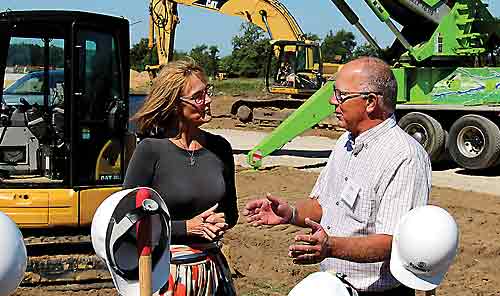It’s fitting, then, that Indiana spent 2018 celebrating new connections on a global scale. State and local leaders are eager to attract global investment as well as technology jobs, and know that they need to make it easier to travel between Indiana and overseas destinations. That’s why a new Indianapolis-to-Paris nonstop that launched in 2018 generated lots of local excitement. It’s not just about shuttling tourists and businesspeople, either. GE Aviation in Lafayette, for example, regularly ships components from Indiana to France, and now can do so more efficiently. “Connectivity is important,” says Elaine Bedel, president of the Indiana Economic Development Corp.
What Makes the Indiana Economy Tick?
Indiana has a diverse economy with industry sectors including advanced manufacturing, life sciences, information technology, agribusiness, and others driving economic growth.
-
Jasper Group
Orleans, INBusiness furniture maker Jasper Group has acquired a 1.2 million-square-foot manufacturing facility in the community of Orleans, with plans to add more than 300 jobs by 2021.
-
Winnebago
Northern INRV maker Winnebago has committed 200 or more new jobs with an expansion in northern Indiana.
-
Aardvark Straws
Fort Wayne, INAardvark Straws recently opened a new Fort Wayne facility, and is working through a months’ long list of back orders, now that paper straws are a hot alternative to plastic.
-
Infosys
Indianapolis, INIndia-based Infosys plans to build its U.S. education center at the edge of Indianapolis International Airport, adding 1,000 jobs to the 2,000 already committed to its Indianapolis U.S. innovation and technology hub
-
Socio
Indianapolis, INThe Indianapolis expansion of Socio, a software-as-a-services company, is expected to create 100 new jobs.
-
Rural Sourcing
Fort Wayne, INA new software development center that is expected to create about 130 jobs will be opened by rural Sourcing in Fort Wayne.
-
Amazon
Johnson County, INAmazon is bringing more than 1,200 jobs to Johnson County, south of Indianapolis.
-
FedEx
Indianapolis, INFedEx is in the midst of expanding its Indianapolis hub, already the company’s second-biggest, with 16 new aircraft gates and a beefed-up capacity.
-
Republic Airways
Indianapolis, INIndianapolis-based Republic Airways is creating a flight training academy and has pledged 600 new jobs.
-
OrthoPediatrics Corp.
Warsaw, INOrthoPediatrics Corp. plans to expand in Warsaw, Indiana, which was the site of the first orthopedic device manufacturer more than a century ago
-
Greenleaf Foods
Shelbyville, INGreenleaf Foods, a subsidiary of a Canadian food processor, is building a quarter-million-square-foot facility in Shelbyville that’ll become the largest plant-based protein facility in North America.
-
Solinftec
West Lafayette, INBrazil-based Solinftec has chosen Purdue University’s research park in West Lafayette for its U.S. headquarters.
-
Integrity Defense Services
Springville, INIn 2018, Integrity Defense Services committed 160 support jobs in the Crane area, which is home to Naval Support Activity Crane.
What makes the Indiana economy tick, and what is driving it into the future? Bedel lists a half dozen sectors of interest:
• Advanced manufacturing — More than 14,000 new manufacturing jobs have been pledged in the past year or so, in more than 160 different deals with a combined investment value approaching $6 billion. Business furniture maker Jasper Group, for example, acquired a 1.2 million-square-foot manufacturing facility in the community of Orleans, with plans to add more than 300 jobs by 2021. RV maker Winnebago committed 200 or more new jobs with an expansion in northern Indiana. Aardvark Straws committed a couple hundred new jobs, recently opened a new Fort Wayne facility, and is working through a months’ long list of back orders, now that paper straws are a hot alternative to plastic. Manufacturing, says Bedel, has been a big economic driver in Indiana for generations, and still is. “About 20 percent of our workforce works in manufacturing,” she notes.
• Information technology — Indiana landed more than five dozen IT-related commitments in the past year or so, worth more than $600 million in investment and nearly 6,000 new jobs. One of the biggest stories was the announcement last year that India-based Infosys would build its U.S. education center at the edge of Indianapolis International Airport. Infosys had just opened its first U.S. innovation and technology hub in Indianapolis earlier in 2018, and the education center plan upped its job commitment from 2,000 to 3,000 new jobs by 2023. The company’s Ravi Kumar explained the expanded commitment by remarking that “Indiana is the right place, at the right time, with the right business climate.”
Meanwhile, Socio, a software-as-a-services company, promised 100 new jobs as part of its Indianapolis expansion. And rural Sourcing chose Fort Wayne for a new software development center that’ll create about 130 jobs.
• Logistics and transportation — This thriving sector saw two dozen commitments and the promise of more than 5,000 new jobs over the past year. Amazon is bringing more than 1,200 jobs to Johnson County, south of Indianapolis. FedEx is in the midst of expanding its Indianapolis hub, already the company’s second-biggest, with 16 new aircraft gates and a beefed-up capacity. Indianapolis-based Republic Airways is creating a flight training academy and has pledged 600 new jobs.
• Life sciences — A sector boasting thousands of Indiana jobs, the life sciences sector keeps adding more. The state is home to pharmaceutical giant Eli Lilly & Co., which is pumping millions of dollars into its technology center location. The northern Indiana community of Warsaw was the site of the first orthopedic device manufacturer more than a century ago and is now home to multiple competing manufacturers. One of 2018’s headlines was the promised expansion of OrthoPediatrics Corp.’s headquarters in Warsaw.
• Agriculture and ag-biosciences — Indiana is well-known for agriculture, ranking fifth in corn production, fourth in soybeans, fifth in hogs, second in tomatoes for processing…and it’s #1 in ducks! That’s a magnet for ag production businesses, which are creating jobs by the bushel. For example, Greenleaf Foods, a subsidiary of a Canadian food processor, is building a quarter-million-square-foot facility in Shelbyville that’ll become the largest plant-based protein facility in North America.
Beyond that, says Bedel, is a push in ag technologies: “How do we improve upon traditional farming?” One example is Solinftec, a Brazilian company that chose Purdue University’s research park in West Lafayette for its U.S. headquarters. The company helps farmers aggregate data from sensors in fields and on equipment.

In Indianapolis, Rolls-Royce makes engines for numerous U.S. Air Force aircraft, and the company is angling for a contract to supply replacement engines for the B-52 fleet. If it lands the deal, more jobs will result. Bedel says the state is working to assist companies such as Rolls-Royce compete successfully for military contracts. “We’re trying to help businesses with what the Defense Department needs.”
Fulfilling Workforce Needs and Changing Misconceptions
Bedel says Indiana’s general business climate has been a calling card for expanding companies. “We are very pro-business,” she says, with low taxes, a low cost of doing business, a low cost of living, and a state government with strong cash reserves and a good bond rating. Those last two points, she adds, give businesses comfort that the business climate won’t be eroding: “You want to know once you get there that things are stable.”
The cost of living, she says, has been a powerful draw in persuading technology companies to consider an Indiana address. “If you’re paying someone a salary of $100,000, to use a round number, it would take over $300,000 to have the same quality of life in the San Francisco area.”
That points to the importance of putting the right people on the payroll, and like a lot of states, Indiana doesn’t take for granted the ability to offer appropriately skilled workers. “When you have low unemployment, lower than the national average, that’s one question we’re always getting; how will we find the workforce?” Bedel notes.
Indiana has responded to that challenge in a number of ways, including the Next Level Jobs program. The program offers free job training to eligible individuals in a wide range of in-demand fields, in sectors including advanced manufacturing, building and construction, health and life sciences, IT and business services, and transportation and logistics. For employers, the program offers generous reimbursement for training the workforce in various high-growth fields.
As soon as a potential employer decides to locate or expand in Indiana, officials go to work trying to solve the workforce puzzle, Bedel explains. “We’ll help them map out their pipeline,” she says. The work of Ascend Indiana provides an example. The organization helps connect talent with opportunities and, as needed, helps develop talent in partnership with businesses. “We have great collaborations in the state when we call upon universities or a community college or even our high schools,” Bedel says.
Beyond preparing workers already in Indiana, the state has quality-of life-initiatives aimed at helping Indiana attract new residents, including younger workers. A multimillion-dollar trails program, for example, has a goal of ensuring that every Indiana resident is no more than five miles away from a trail. The Indiana Regional Cities Initiative, meanwhile, provides funding for collaborative quality-of-life efforts bringing regions together to make their areas more attractive for talent.
Among some people outside of the state, particularly on the coasts, “there is a perception that nothing is going on in Indiana,” Bedel acknowledges. “We’re starting to make that turn around. We have to get them to come to Indiana and try it out. It pays off, she says, when “once they get here, they don’t want to leave. I hear that often.”




